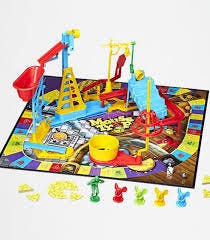Mouse Trap Has Become a Life-Sized Attraction
Why would someone build a life-sized version of the well-known board game? To teach.
Mouse Trap was one of my favorite board games for the process of creating the three-dimensional contraption while playing and watching it work. It’s a unique function of this clever game that continues to entertain.
So when I discovered there was a life-sized version that travels around the country, I had to learn about it.
Mouse Trap, the board game
Marvin Glass and Associates created Mouse Trap. Founded in 1941 in Chicago, he helped develop a variety of toys and games for Milton Bradley, Parker Brothers, and other companies, including:
Rock ‘Em Sock ‘Em Robots,
Lite Brite,
Ants in the Pants,
Operation, and
Simon, among many others.
Glass, along with Gordon Barlow, spawned the idea for Mouse Trap. Hank Kramer designed the version released in 1963. Four years later Glass and Barlow received a patent for it.
The game has been revised over the years, but the basic components have remained the same. Among the familiar elements of the trap (twenty-four pieces total) include:
a bathtub,
a figurine of a diving man,
a marble,
a zigzagging stairway,
a rain gutter,
a washtub, and
the cage.
There are also four mouse tokens, eight “pieces of cheese,” and a die for moving around the board.
Hasbro shows you how to assemble the trap:
(In fairness, I should mention it has a lot of one-star reviews from customers on Google saying it doesn’t work the way it should—but it has more five-star reviews.)
In the modern version, the game begins with the trap fully assembled. The goal is to collect all the slices of a wheel of cheese. When you land on the designated spaces, you can set off the trap and acquire cheese from other players. Previously, the trap was built as you play and the goal was to be the last player to not get caught.
Rube Goldberg-like contraption
Mouse Trap owes a debt to artist Rube Goldberg, famous today for conceiving bizarre devices.
Goldberg drew cartoons of elaborate machines that performed simple tasks. He won a Pulitzer Prize in 1948. He was the first president of the National Cartoonists Society, who present an award named for him annually. His name has become an adjective to describe any complicated device that does something simple.
The opening credits of Back to the Future depict an example of a Goldbergian device.
But—a life-sized Mouse Trap?
Mark Perez’ life-sized Mouse Trap
In 2005, Mark Perez fulfilled a lifelong dream by assembling a team to help him create a giant version of Mouse Trap, similar to the board game.
He and his associates take it on the road, entertaining crowds and using it to teach children about science and engineering.
I believe that in these times of seemingly endless virtual and digital experiences, it is crucial for kids and adults alike to have a real life encounter with the scientific principles that govern our world. The plan is to continue this proven model and rise to the levels that only grant institutions can provide for.
Perez and his crew put on a carnival-like performance with the trap, with original music, dancing, and doing things like smashing cars. Perez says the educational value makes the spectacle worthwhile:
You can go online and see all of these simple machines, but actually seeing it in person, watching a compressed oil spring release its energy to push a rod to make a bowling ball roll down an incline plane, when you experience it and hear the clanging of the metal, it is different. We make it fun.
—————————
Have you seen Mark Perez’ giant Mouse Trap?






